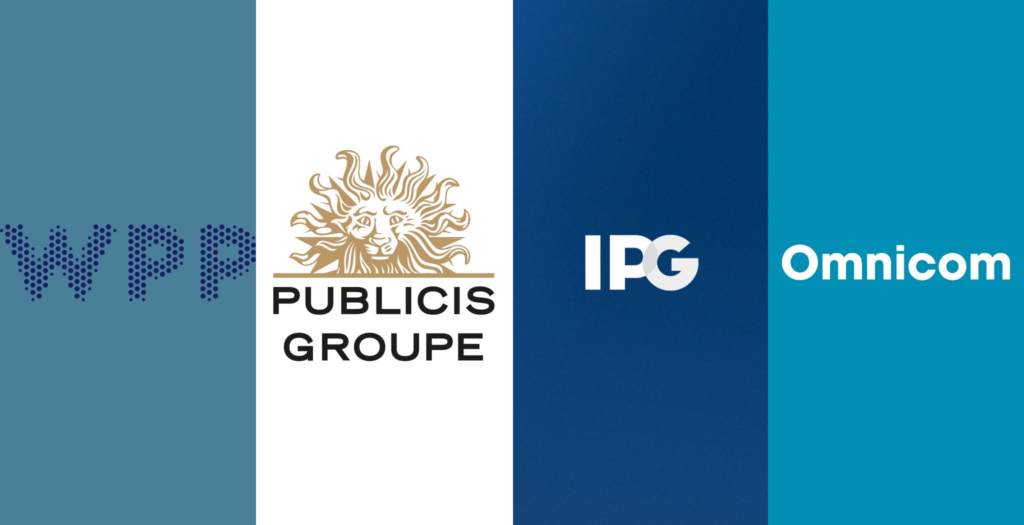When VideoWeek last dived into the ‘big four’ agency groups’ (WPP, Publicis, Omnicom, and Interpublic Group) earnings results back in March, just over a week had passed since Russia had invaded Ukraine. The set of earnings in question, covering Q4 in 2021, were obviously completely unaffected, and all except WPP’s had been released prior to the invasion.
WPP’s Mark Read acknowledged that the war in Eastern Europe could impact results further down the line, but nonetheless maintained a forecast of five percent organic growth for the full year. This might have seemed optimistic in the following weeks as the war intensified and the economic ripples spread across the world. And yet as we enter Q4, it looks likely that all of the big four holding groups actually underestimated full-year growth, as all four have upped their guidance multiple times.
Looking at the most recent set of results, there are some shared trends in where this growth has come from, but also differences in priorities, and in expectations around client behaviour. Here’s our breakdown of how the big four fared in Q3.
WPP lags behind in growth
There was a relatively wide spread in terms of the organic growth delivered by each agency group in Q3. Publicis led the way this time, with organic year-on-year growth of 10.3 percent. Omnicom meanwhile reported 7.5 percent organic growth, IPG posted 5.6 percent organic growth, and WPP trailed with 3.8 percent growth in like-for-like revenues less passthrough costs.
WPP attributed its own results in part to struggles in China, where it has a relatively large business. Continued COVID lockdowns across the country hurt client investment – though others reported growth in China despite these lockdowns.
It’s worth of course taking into consideration each group’s strength in Q3 2021 when judging year-on-year growth – and indeed WPP posted the strongest organic growth in 2021 of the four, contributing to a less favourable comparison this year.
Nonetheless, it’s hard to not see something of a relative decline for WPP. This time last year, WPP had only just lost its place as the biggest of the big four, as its market cap fell behind Publicis. One year on, it’s now the smallest of the big four. WPP’s relative market cap hasn’t been helped by the weakening of the pound against the dollar, but it’s also seen the biggest fall in its share price over the past year, down by over 25 percent.
Publicis and Omnicom post strong growth in Western markets
It’s fairly standard for all of the big four to post strong growth in countries outside of the US and Europe, since they tend to have more room for growth in these markets, and that continued to be the case in Q3 – with the exception of WPP’s struggles in China.
Latin America was strong across the board: IPG posted 19.8 percent organic growth across the region, while Publicis and Omnicom grew by 19.4 percent and 13.1 percent respectively. WPP grew organically by 19.7 percent in Brazil specifically.
WPP meanwhile saw strong growth in India (up by 10.7 percent), while Omnicom performed well in the Middle East & Africa (up by 13.1 percent).
But Publicis and Omnicom found significantly more growth in their primary markets, compared with WPP and IPG. Publicis’ organic growth was 11.2 percent in the US and 11.1 percent in Europe, with the UK specifically up by 22.6 percent. Omnicom meanwhile reported organic growth of 7.6 percent in the US, 11.5 percent in the UK, and 6.0 percent in other European markets. For IPG and WPP meanwhile, growth in these markets sat under five percent.
Growth is highest outside of traditional media
Unsurprisingly, all four agency groups cited client investment in digital, technology, and data as key factors in helping drive growth. Uniquely for IPG, growth in its business segment relating to these areas was actually low, with total media, data and engagement solutions revenues up by just 3.8 percent organically, and down 0.2 percent on a reported basis. IPG said that IPG Mediabrands, which sits in this segment, actually saw double digit growth, but that struggles within two of its specialist agencies weighed down the overall segment.
Across the board, business sectors outside of traditional advertising services tended to see the highest growth. Publicis picked out Publicis Sapient, its business transformation unit, and Epsilon, its data business, as its two standout performers, with 18.2 percent growth and 13.9 percent growth respectively. Omnicom meanwhile saw 16.3 percent growth in precision marketing and 11.1 percent growth in commerce and brand consulting, compared to 5.9 percent growth in advertising and media.
This partly explains the holding groups’ confidence in keeping organic growth projections relatively high. While they’ve generally not seen client pullbacks in media spending just yet (see below), even if that does happen further down the line, the agencies’ broader business transformation and consulting units may be less volatile. Partly that’s due to the fact that clients invest in those areas as part of their longer term development. But also contracts for those businesses are more stable, providing more reliable revenue streams.
Several of the CEOs referenced this fact on their earnings calls. Publicis Groupe CEO Arthur Sadoun said that thanks to its acquisitions of Publicis Sapient and Epsilon, the company has “radically changed” its go-to-market. “This enabled us today to help our clients weather the macroeconomic challenges in the context of inflation, where they need to drive growth while generating efficiencies,” he said.
Clients are not withdrawing, but some are putting contingency plans in place
Universally, the holding groups reported that they’ve not seen significant pullbacks in marketing spend from advertisers – at least to the extent that it’s had a material impact on results.
One constant question this year has been why the holding groups haven’t seen pauses in ad spend, while social platforms have. WPP’s Mark Read, when posed this question on the earnings call, suggested the answer may partly be in the fact that agency groups have different client bases compared with social platforms.
Read suggested this was more down to the size of the holding groups’ clients, rather than the industries they operate in – and this bears out in the earnings reports. Publicis has seen increased client investment across the first nine months of the year in every single vertical, with retail and travel & leisure both seeing the biggest jumps at 21 percent. WPP meanwhile has seen growth in every vertical except for automotive (down 6.7 percent) and government, public sector, and non-profit (down 20.5 percent). The latter is explainable by the unusually high levels of government ad spending last year due to the pandemic.
The holding group CEOs generally agreed that it’s possible brands may start to pull back spend if economic conditions deteriorate further, though there were slight differences in expectations.
WPP’s Mark Read mentioned that two major FMCG clients have discussed increasing their marketing spend in Q4, and that he’s seen plenty of other signs of optimism. And Publicis’ Sadoun said that “what we’re experiencing is that our clients, despite the challenges they’re experiencing, and perhaps because of the challenges they’re facing, won’t stop investing in marketing and business transformation”.
IPG’s Philippe Krakowsky struck a more cautious tone. He said the majority of IPG’s clients have asked for contingency planning, in case macroeconomic conditions deteriorate further.
Commerce is a major strategic focus
Agency transformation has been a big strategic focus for the agency groups in recent years, and continues to be, judging by the CEOs comments. But the holding groups are clearly at a point now where they feel a lot of this internal transformation work is already complete.
WPP’s Read said in an interview with Adweek following the results that WPP is now “much more than just an advertising company, and while [traditional advertising] remains important, our business is broader than that and it will continue to be broader than that”. Omnicom’s John Wren meanwhile said the Omnicom’s portfolio nowadays “isn’t comparable really to what our portfolio was three-and-a-half, four years ago”. And as mentioned earlier, Publicis’ Arthur Sadoun said his company’s go-to-market has “radically changed”.
Another strategic focus for the agency groups which stood out in this set of results is commerce. While it’s popped up plenty of times in previous earning calls, it’s usually been alongside other strategic focuses de jour like CTV, first-party data, and the metaverse.
This quarter commerce was a more significant focus for all of the big four in one form or another.
Publicis in particular out commerce centre stage. “In the next years we will accelerate on what will shape the future of our business, the new age of business,” said Arthur Sadoun. “Thanks to data and technology, we know that today every brand experience, from a text to a tweet, from a TikTok video to television sports, from store visits to transactions in the metaverse, everything has the potential to become a commerce experience.”
IPG’s Krakowsky similarly framed commerce as a priority. “Now the convergence of media and entertainment with the impact of technology on the retail sector is leading to another major growth opportunity for brands,” he said on IPG’s earnings call. “And that’s the evolving world of commerce and direct-to-consumer business models.”
Omnicom’s John Wren and WPP’s Mark Read meanwhile highlighted their own agencies’ investments in commerce related business during the previous quarter.
Increased forecasts across the board
A final consistent theme across all of the agency groups was that following their Q3 results, all have raised their full-year expectations for 2022.
Omnciom and Publicis now have the highest full-year forecasts for organic growth. Omnicom raised its guidance from 6.5-7.0 percent up to 8.0-8.5 percent. Publicis meanwhile increased its forecast from 6.0-7.0 percent organic growth, up to 8.5 percent.
IPG raised its full year guidance from 6.5 to 7.0 percent. And WPP made the smallest increase, narrowing its forecasted range from 6.0-7.0 percent, up to 6.5-7.0 percent.





